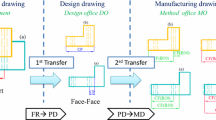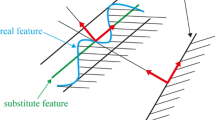Abstract
Functional tolerancing described in definition drawing of mechanical parts constitutes a contract to be respected by manufacturers. Process engineers have to choose process plans able to manufacture part respecting functional requirements and have to determine manufacturing specifications for each phase. Tolerance zone transfer method offers a three-dimensional algorithm of manufacturing specifications generation with International Organization for Standardization (ISO) standards. Analysis line method, developed in this article, establishes the calculus relation of the results of the tolerance chains according to the tolerances of manufacturing specifications to allow the tolerance synthesis. In this paper, the analysis line method is presented using an example. The aim is to show the hypotheses made during transfers in the context of ISO standards of tolerancing and to define accurately the datum reference frames used and deviations between these frames at particular points named analysis points.
Similar content being viewed by others
References
Anselmetti B (1983) Simulation d’usinage bidimensionnelle sur un exemple en tournage commande numérique, revue Mécanique Matériaux Electricité n°398
Anselmetti B, Bourdet P (1993) Optimization of a workpiece considering production requirements. Rev Computer in Industry 21:23–34
Anselmetti B, Louati H (2005) Generation of manufacturing tolerancing with ISO standard. Int J Mach Tool Manuf 45:1145–1153
Anselmetti B (2006) ISO manufacturing tolerancing with tolerance zone transfer. Revue int d’ingénierie mécanique 2(n°1–2):57–70
Anselmetti B (2009) Cotation fonctionnelle tridimensionnelle et statistique, Lavoisier
Anselmetti B Part optimization and tolerances synthesis. Int J Adv Manuf Technol. doi:10.1007/s00170–009–2355–6, en ligne 24 oct 2009
Ayadi B, Anselmetti B, Bouaziz Z, Zghal A (2008) Three-dimensional modelling of manufacturing tolerancing using the ascendant approach. Int J Adv Manuf Technol 39:279–290. doi:10.1007/s00170-007–1225–3
Ballot E, Bourdet P (1997) A computational method for the consequences of geometrical errors in mechanisms, Proceeding of CIRP Computer Aided Tolerancing 5th seminar, Toronto, Canada, pp137,148
Bellacicco A, Sellakh, Arotcarena P, Riviere A, Méthode rationnelle de tolérancement 3D du process, 9th CIRP seminar on CAT, Phoenix, USA
Bennis F, Pino L, Fortin C (1998) Geometric tolerance transfer for manufacturing by an algebraic method. Integrated Design and Manufacturing in Mechanical Engineering’98: Proceedings of the 2nd IDMME Conference (Compiègne, France), pp. 373–380
Benea R, Cloutier G, Fortin C (2003) Process plan validation including process deviations and machine tool errors. Geometric product specification and verification: integration of functionality. Kluwer: Netherlands. pp 197–206 5
Bourdet P (1973) Chaînes de cotes de fabrication, Revue l’Ingénieur et le technicien de l’enseignement technique, n°191
Bourdet P, Ballot E (1995) Équations formelles et tridimensionnelles des chaînes de dimensions dans les mécanismes, 4th CIRP Seminar on Computer Aided Tolerancing, University of Tokyo 5–6 April
Bourdet P, Mathieu L, Lartigue C, Ballu A (1996) The concept of small displacement torsor in metrology. In: Advanced mathematical tool in metrology II in series on advances in mathematics for applied sciences. World Scientific, vol. 40
Caux M, Anselmetti B (2011) 3D ISO manufacturing specifications with vectorial representation of tolerance zones. Int J Adv Manufact Tech. doi:10.107/s00170-011-3638-2
Clement A, Le Pivert P, Riviere A (1996) Modélisation des procédés d’usinage. Simulation 3D réaliste. Conférence IDMME 96, Nantes Avril 96, pp 355–364
Dantan JY, Ball A, Thiebaut F, Bourdet P (2000) Functional and manufacturing specifications: validation of a process plan, 3th IDMME Montréal
Desrochers A, Verheul S (1999) A three-dimensional tolerance transfer methodology Proc of the 6th CIRP seminar on computer aided tolerancing, Twente, Netherlands, pp. 83–92
Dong Z (1997) Tolerance synthesis by manufacturing cost modeling and design optimization. In: Zhang HC (ed) Advanced tolerancing techniques. Wiley, New York, pp 233–260
Fainguelernt D, Weill R, Bourdet P (1986) Computer-aided tolerancing and dimensioning in process planning. Ann of CIRP 35(1):381–386
Hong YS, Chang TC (2002) A comprehensive review of tolerancing research. Int J Prod Res 40(n°11):2425–2459
Huang SH, Liu Q (2003) Rigorous application of tolerance analysis in setup planning. Int J Adv Manuf Technol 3:196–207
Jaballi K, Bellacicco A, Louati J, Riviere A, Haddar M Dimensioning of the intermediate states of the machined phases “DISMP” approach. Int J Adv Manuf Technol. doi:10.1007/s00170-009–2040–9
Ji P, Ke M, Ahluwalia RS (1995) Computer aided operational dimensioning for process planning. Int J Mach Tools Manuf 35(10):1353–1362
Kanaï S, Onozuka M, Takahashi H (1995) Optimal Tolerance synthesis by genetic algorithm under the machining and assembling constraints, 4th CIRP CAT Seminar, Tokyo, Japan, pp. 263–282
Kamali N, Vignat F, Villeneuve F (2009) Simulation of the geometrical defects of manufacturing. Int J Adv Manuf Technol 45:631–648. doi:10.1007/s00170-009–2001–3
Le Pivert P (1998) Contribution à la modélisation et à la simulation réaliste des processus d’usinage, these Ecole Centrale de Paris
Lin A, Lin M-Y, Ho H-B (1999) CAPP and its integration with tolerance charts for machining of aircraft components. Rev Computers Ind V38:263–283
Louati J, Ayadi B, Bouaziz Z, Haddar M (2006) Three-dimensional model-ling of geometric defaults to optimize a manufactured part setting. Int J Adv Manuf Technol 29(No 3–4):342–348
Teissandier D, Couétard Y, Gérard A (1997) Three–dimensional functional tolerancing with proportionnel assemblies clearance volume (U.P.E.L.), application to setup planning, 5th CIRP CAT Seminar, Toronto, Canada, pp.113–124
Thiebaut F (2001) Contribution à la définition d’un moyen unifié de gestion de la géométrie réaliste basé sur le calcul des lois de comportement des mécanismes. Thèse ENS Cachan
Thimm G, Lin J (2005) Redimensioning parts for manufacturability: a design rewriting system. Int J Adv Manuf Technol 26:399–404
Tichadou S, Legoff O, Hascoet JY (2005) 3D geometrical manufacturing simulation compared approaches between integrated CAD/CAM system and small displacement torsor models, IDMME, pp 201–214
Vignat F, Villeneuve F (2007) A numerical approach for 3D manufacturing tolerances synthesis. 10th CIRP Conference on CAT, Erlangen Germany
Vignat F, Villeneuve F (2007) Analyse et synthèse tridimensionnelles de spécifications de fabrication, pp 311–344, HERMES, Tolérancement géométrique des produits
Villeneuve F, Legoff O, Landon Y (2001) Tolerancing for manufacturing: a three dimensional model. Int J prod res V39(n°8):1625–1648
Villeneuve F, Vignat F., Simulation of the manufacturing process: generic resolution of the positioning problem, 9th CIRP seminar on CAT, Tempe, USA
Zhang Y, Hu W, Rong Y, Yen DW (2001) Graph-based set-up planning and tolerance decomposition for computer-aided fixture design. Int J prod res V39(n°14):3109–3126
Author information
Authors and Affiliations
Corresponding author
Appendix: Setting-up on three perpendicular planes
Appendix: Setting-up on three perpendicular planes
This appendix depicts a particular case of general relations established in Section 3.4, with three planes perpendicular each one to the others:
With:
1.1 Analysis line parallel to the secondary plane
If fy = 0 and fz # 0, The analysis line is parallel to the secondary plane, but is nonperpendicular to the tertiary plane. The position of the secondary plane has no effect on F point. Only its orientation around z has influence. P point can be used to void the effect of rotations in x and y.
Then the relation will be:
-
The vector t = ±x is chosen so that tx will have the same sign as fx.
-
The vector p = ±z is chosen so that pz will have the same sing as fz.
-
If Lz > 0, r = z. If Lz < 0, r = −z.
1.2 Analysis line parallel to the primary plane
If fz = 0 and fy # 0, The analysis line is parallel to the primary plane. The primary plane only orientates the part.
The relation becomes:
The coefficients Kt and Ks must be positive because the defect influences only add up. This rule allows us to orientate the vectors s and t:
-
The vector t = ±x is chosen so that tx will have the same sign as fx.
-
The vector s = ±y is chosen so that sy will have the same sign than fy.
α is th rotation around x and β the one around y.
To study the maximum influence of the plane angle, the direction r of the resultant is determined:
The angular displacement of this plane around r is noted a (primary plane, r).
1.3 Analysis line perpendicular to the tertiary plane
If fy = 0 and fz = 0, the analysis line is perpendicular to the tertiary plane. In this case, the position is given by the tertiary point. The relation is:
-
The vector t = ±x is chosen so that tx will have the same sign as fx.
-
If Lz > 0, r1 = y. If Lz < 0, r1 = −y.
-
If Ly > 0, r2 = z. If Ly < 0, r2 = −z
Rights and permissions
About this article
Cite this article
Anselmetti, B. ISO manufacturing tolerancing: three-dimensional transfer with analysis line method. Int J Adv Manuf Technol 61, 1085–1099 (2012). https://doi.org/10.1007/s00170-011-3769-5
Received:
Accepted:
Published:
Issue Date:
DOI: https://doi.org/10.1007/s00170-011-3769-5




